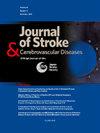识别与中风风险相关的神经文本标记
IF 1.8
4区 医学
Q3 NEUROSCIENCES
Journal of Stroke & Cerebrovascular Diseases
Pub Date : 2025-06-11
DOI:10.1016/j.jstrokecerebrovasdis.2025.108376
引用次数: 0
摘要
背景:延迟或漏诊卒中与不良预后相关。我们利用自然语言处理来自非神经急诊科(ED)的记录来识别与ED出院后30天卒中住院相关的卒中表现的文本短语。方法回顾性分析两家学术医疗中心卒中(病例)和肠胃炎(对照)患者入院前30天发生ED的病例。医学概念摘自急诊会诊记录。使用来自一家医院(发现队列)并在另一家医院(验证队列)验证的数据,采用统计分析来检测指示中风体征和症状的神经学文本标记。我们进一步比较了两个队列的弹性网络模型的系数和预测性能。结果在987例患者(51%卒中患者)中,我们发现58个医学概念与卒中病例有统计学显著正相关。采用专家评审将这些医学概念合并为11个指示中风表现的文本标记(如协调、语言)。在433例患者(24%卒中)的验证队列中分析时,标记物显示出正相关的外部有效性。在每个中心导出的弹性网模型在系数大小和预测性能上证明是等效的,证明了通用性。结论我们在卒中诊断前30天检测并验证了ED患者卒中体征和症状特征的神经文本标记。这些标志物的存在可用于提示额外的神经学评估,以防止延迟中风诊断。本文章由计算机程序翻译,如有差异,请以英文原文为准。
Identification of neurological text markers associated with risk of stroke
Background
Delayed or missed stroke diagnosis is associated with poor outcomes. We utilized natural language processing of notes from non-neurological emergency department (ED) encounters to identify text phrases indicating stroke presentations that are associated with stroke hospitalization 30 days after ED discharge.
Methods
We conducted a retrospective analysis of stroke (case) and gastroenteritis (matched-control) patients at two academic medical centers who had an ED encounter 30 days before index admission diagnosis. Medical concepts were extracted from the ED encounter notes. Statistical analysis was used to detect neurological text markers indicating stroke signs and symptoms using data from one hospital (discovery cohort) and validated in the second (validation cohort). We further compared the coefficients and the predictive performance of an elastic net model of both cohorts.
Results
We detected 58 medical concepts with a statistically significant positive association with stroke cases in the discovery cohort of 987 patients (51 % stroke). Expert review was used to combine these medical concepts into 11 text markers indicative of stroke presentations (e.g., coordination, language). Markers demonstrated external validity in terms of positive association when analyzed in the validation cohort of 433 patients (24 % stroke). Elastic net models derived at each center demonstrated equivalence in coefficient magnitudes and predictive performance, demonstrating generalizability.
Conclusion
We detected and validated neurologic text markers characteristic of stroke signs and symptoms at an ED encounter 30 days before the stroke diagnosis. The presence of these markers could be used to prompt additional neurologic evaluation to prevent delayed stroke diagnosis.
求助全文
通过发布文献求助,成功后即可免费获取论文全文。
去求助
来源期刊

Journal of Stroke & Cerebrovascular Diseases
Medicine-Surgery
CiteScore
5.00
自引率
4.00%
发文量
583
审稿时长
62 days
期刊介绍:
The Journal of Stroke & Cerebrovascular Diseases publishes original papers on basic and clinical science related to the fields of stroke and cerebrovascular diseases. The Journal also features review articles, controversies, methods and technical notes, selected case reports and other original articles of special nature. Its editorial mission is to focus on prevention and repair of cerebrovascular disease. Clinical papers emphasize medical and surgical aspects of stroke, clinical trials and design, epidemiology, stroke care delivery systems and outcomes, imaging sciences and rehabilitation of stroke. The Journal will be of special interest to specialists involved in caring for patients with cerebrovascular disease, including neurologists, neurosurgeons and cardiologists.
 求助内容:
求助内容: 应助结果提醒方式:
应助结果提醒方式:


